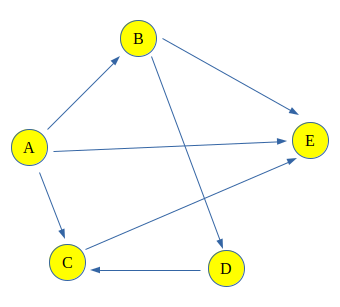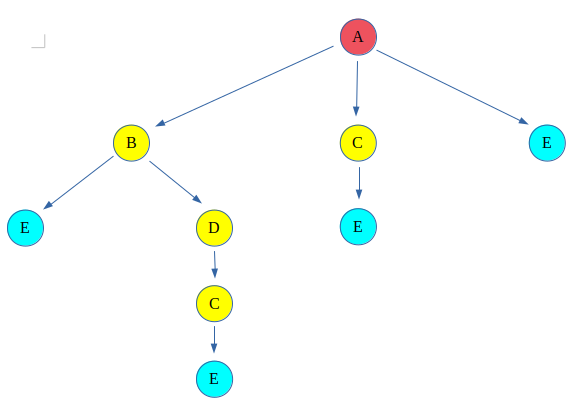计算有向图中两个顶点之间存在的路径或路径的总数。这些路径不包含循环,足够简单的原因是循环包含无限数量的路径,因此会产生问题。
例子:
For the following Graph:
Input: Count paths between A and E
Output : Total paths between A and E are 4
Explanation: The 4 paths between A and E are:
A -> E
A -> B -> E
A -> C -> E
A -> B -> D -> C -> E
Input : Count paths between A and C
Output : Total paths between A and C are 2
Explanation: The 2 paths between A and C are:
A -> C
A -> B -> D -> C方法:
该问题可以使用回溯来解决,即走一条路径并开始在其上行走,并检查它是否将我们引向目标顶点,然后计算路径并回溯以走另一条路径。如果路径没有通向目标顶点,则丢弃该路径。
这种图形遍历称为回溯。
上图的回溯可以显示为:
红色顶点为源顶点,浅蓝色顶点为目标顶点,其余为中间路径或废弃路径。

这给出了源(A)和目标(E)顶点之间的四个路径。
为什么此解决方案不适用于包含循环的图形?
与此相关的问题是,如果现在在C和B之间再增加一个边,它将形成一个循环(B-> D-> C-> B) 。因此,在循环的每个循环之后,长度路径将增加,这将被视为不同的路径,并且由于循环的原因,将有无限多的路径。

算法:
- 创建一个采用图节点索引和目标索引的递归函数。保留全局或静态变量计数以存储计数。
- 如果当前节点是目的地,则增加计数。
- 对于所有相邻节点(即,可从当前节点访问的节点),则使用相邻节点和目标的索引来调用递归函数。
- 打印计数。
执行:
C++
/*
* C++ program to count all paths from a source to a
* destination.
* https://www.geeksforgeeks.org/count-possible-paths-two-vertices/
* Note that the original example has been refactored.
*/
#include
#include
using namespace std;
/*
* A directed graph using adjacency list representation;
* every vertex holds a list of all neighbouring vertices
* that can be reached from it.
*/
class Graph {
public:
// Construct the graph given the number of vertices...
Graph(int vertices);
// Specify an edge between two vertices
void add_edge(int src, int dst);
// Call the recursive helper function to count all the
// paths
int count_paths(int src, int dst);
private:
int m_vertices;
list* m_neighbours;
void path_counter(int src, int dst, int& path_count);
};
Graph::Graph(int vertices)
{
m_vertices = vertices; // unused!!
/* An array of linked lists - each element corresponds
to a vertex and will hold a list of neighbours...*/
m_neighbours = new list[vertices];
}
void Graph::add_edge(int src, int dst)
{
m_neighbours[src].push_back(dst);
}
int Graph::count_paths(int src, int dst)
{
int path_count = 0;
path_counter(src, dst, path_count);
return path_count;
}
/*
* A recursive function that counts all paths from src to
* dst. Keep track of the count in the parameter.
*/
void Graph::path_counter(int src, int dst, int& path_count)
{
// If we've reached the destination, then increment
// count...
if (src == dst) {
path_count++;
}
// ...otherwise recurse into all neighbours...
else {
for (auto neighbour : m_neighbours[src]) {
path_counter(neighbour, dst, path_count);
}
}
}
// Tests...
int main()
{
// Create a graph given in the above diagram - see link
Graph g(5);
g.add_edge(0, 1);
g.add_edge(0, 2);
g.add_edge(0, 3);
g.add_edge(1, 3);
g.add_edge(1, 4);
g.add_edge(2, 3);
g.add_edge(2, 4);
// Validate it...
assert(3 == g.count_paths(0, 3));
return 0;
}
Java
// Java program to count all paths from a source
// to a destination.
import java.util.Arrays;
import java.util.Iterator;
import java.util.LinkedList;
// This class represents a directed graph using
// adjacency list representation
class Graph {
// No. of vertices
private int V;
// Array of lists for
// Adjacency List
// Representation
private LinkedList adj[];
@SuppressWarnings("unchecked")
Graph(int v)
{
V = v;
adj = new LinkedList[v];
for (int i = 0; i < v; ++i)
adj[i] = new LinkedList<>();
}
// Method to add an edge into the graph
void addEdge(int v, int w)
{
// Add w to v's list.
adj[v].add(w);
}
// A recursive method to count
// all paths from 'u' to 'd'.
int countPathsUtil(int u, int d,
int pathCount)
{
// If current vertex is same as
// destination, then increment count
if (u == d) {
pathCount++;
}
// Recur for all the vertices
// adjacent to this vertex
else {
Iterator i = adj[u].listIterator();
while (i.hasNext()) {
int n = i.next();
pathCount = countPathsUtil(n, d, pathCount);
}
}
return pathCount;
}
// Returns count of
// paths from 's' to 'd'
int countPaths(int s, int d)
{
// Call the recursive method
// to count all paths
int pathCount = 0;
pathCount = countPathsUtil(s, d,
pathCount);
return pathCount;
}
// Driver Code
public static void main(String args[])
{
Graph g = new Graph(5);
g.addEdge(0, 1);
g.addEdge(0, 2);
g.addEdge(0, 3);
g.addEdge(1, 3);
g.addEdge(2, 3);
g.addEdge(1, 4);
g.addEdge(2, 4);
int s = 0, d = 3;
System.out.println(g.countPaths(s, d));
}
}
// This code is contributed by shubhamjd. Python3
# Python 3 program to count all paths
# from a source to a destination.
# A directed graph using adjacency
# list representation
class Graph:
def __init__(self, V):
self.V = V
self.adj = [[] for i in range(V)]
def addEdge(self, u, v):
# Add v to u’s list.
self.adj[u].append(v)
# Returns count of paths from 's' to 'd'
def countPaths(self, s, d):
# Mark all the vertices
# as not visited
visited = [False] * self.V
# Call the recursive helper
# function to print all paths
pathCount = [0]
self.countPathsUtil(s, d, visited, pathCount)
return pathCount[0]
# A recursive function to print all paths
# from 'u' to 'd'. visited[] keeps track
# of vertices in current path. path[]
# stores actual vertices and path_index
# is current index in path[]
def countPathsUtil(self, u, d,
visited, pathCount):
visited[u] = True
# If current vertex is same as
# destination, then increment count
if (u == d):
pathCount[0] += 1
# If current vertex is not destination
else:
# Recur for all the vertices
# adjacent to current vertex
i = 0
while i < len(self.adj[u]):
if (not visited[self.adj[u][i]]):
self.countPathsUtil(self.adj[u][i], d,
visited, pathCount)
i += 1
visited[u] = False
# Driver Code
if __name__ == '__main__':
# Create a graph given in the
# above diagram
g = Graph(4)
g.addEdge(0, 1)
g.addEdge(0, 2)
g.addEdge(0, 3)
g.addEdge(2, 0)
g.addEdge(2, 1)
g.addEdge(1, 3)
s = 2
d = 3
print(g.countPaths(s, d))
# This code is contributed by PranchalKC#
// C# program to count all paths from a source
// to a destination.
using System;
using System.Collections.Generic;
// This class represents a directed graph using
// adjacency list representation
public class Graph {
// No. of vertices
int V;
// Array of lists for
// Adjacency List
// Representation
private List[] adj;
Graph(int v)
{
V = v;
adj = new List[v];
for (int i = 0; i < v; ++i)
adj[i] = new List();
}
// Method to add an edge into the graph
void addEdge(int v, int w)
{
// Add w to v's list.
adj[v].Add(w);
}
// A recursive method to count
// all paths from 'u' to 'd'.
int countPathsUtil(int u, int d,
int pathCount)
{
// If current vertex is same as
// destination, then increment count
if (u == d) {
pathCount++;
}
// Recur for all the vertices
// adjacent to this vertex
else {
foreach(int i in adj[u])
{
int n = i;
pathCount = countPathsUtil(n, d,
pathCount);
}
}
return pathCount;
}
// Returns count of
// paths from 's' to 'd'
int countPaths(int s, int d)
{
// Call the recursive method
// to count all paths
int pathCount = 0;
pathCount = countPathsUtil(s, d,
pathCount);
return pathCount;
}
// Driver Code
public static void Main(String[] args)
{
Graph g = new Graph(5);
g.addEdge(0, 1);
g.addEdge(0, 2);
g.addEdge(0, 3);
g.addEdge(1, 3);
g.addEdge(2, 3);
g.addEdge(1, 4);
g.addEdge(2, 4);
int s = 0, d = 3;
Console.WriteLine(g.countPaths(s, d));
}
}
// This code is contributed by Rajput-Ji 输出:
3复杂度分析:
- 时间复杂度: O(N!)。
如果该图完整,则大约为N!递归调用,因此时间复杂度为O(N!) - 空间复杂度: O(1)。
由于不需要额外的空间。